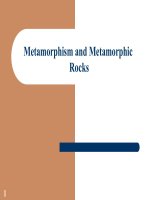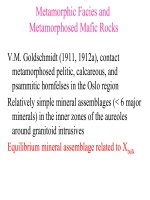Metamorphic rocks (2)
Bạn đang xem bản rút gọn của tài liệu. Xem và tải ngay bản đầy đủ của tài liệu tại đây (957.71 KB, 28 trang )
Metamorphic rocks
When rocks are baked by heat of molten magma or squeezed by the
movements of huge tectonic plates or by the pressure of overlying
thick succession of rocks
They are altered or changed beyond their recognition
i.e. change in Chemical composition, texture and
structure
Metamorphic rocks
Metamorphism
Is the process that occur in rocks
due to the effects of
High
temperature
High pressure
Chemically active fluids
Temperature
The source of temperature is either from magma or due to the
depth factor
Metamorphism usually result into change in min. comp. and
texture of rocks (Ig. and Sed.) which are subjected to temp. >
1000 C and pressure > 1000’s Mpa.
Low-grade metamorphism:
Occurs at about 1000 C to 5000 C.
High-grade metamorphism:
Occurs at > 5000 C
Pressure
UNIFORM PRESSURE
DIRECT or Differential PRESSURE
- increases with depth due to
increase in overburden.
- increases with depth upto some
- acts vertically downwards and
affects the volume of both liquid
& solids.
- acts in all direction and affects only
on solids resulting into deformation
of shape and change in mineral
composition
-
high temperature is also
associated with (due to depth
factor)
- Lithostatic pressure- due to
overburden
extent, effective in the upper part
of the crust.
- high temperature is not always
associated. to depth factor)
- Stress- due to tectonic forces
min
max
inter
Differential Stress
Uniform Stress
Granite
Granite-Gneiss
STRUCTURES IN METAMORPHIC ROCKS
Foliation: when platy, lamellar or flaky minerals (eg.
sheet silicate minerals the micas: biotite and muscovite,
chlorite, talc, and serpentine), occurring in rock orient
themselves parallel to one another (i.e. perpendicular to
the direction of maximum pressure or stress).
Random
orientation
Of minerals
Preferred
orientation
Of minerals
Lineation: when prismatic or rod-like
minerals (eg. Hornblende, tourmaline etc.)
occurring in a rock orient themselves parallel to
one another (perpendicular to direction of maxi.
Pressure or stress)
SLATY CLEAVAGE
- usually formed during the early stage of
Low-grade Metamorphism due to lithostatic
stress.
- New sheet-structure minerals tends to be
parallel to the bedding planes during
metamorphism.
- however, further deep burial along
the
continental
margin;
compressional forces will cause
deformation (folding).
- hence, the sheet minerals as well as
foliation will no longer be parallel to
the bedding planes, such type of
foliation in fine grained rocks is
called slaty cleavage.
Shale
Slate
PHYLLITES
- usually associated with intermediate grade of metamorphism; where the
mineral grains grows large in size as compare to that seen in slates
-This develops a pronounced foliation where the preferred oriented
minerals are seen.
SCHISTOSE STRUCTURE
- usually formed during intermediate and high grade metamorphism
- Grain size increases and can be seen by naked eye; grains tends to enlarge
with increasing grade of metamorphism; the coarse grained sheet-structure
minerals show preferred orientation
- grain size is the main difference between the slaty structure and schistos
structure.
GNEISSIC STRUCTURE
- usually associated with high-grade regional metamorphism (where
differential stress prevails I.e. tectonic forces)
-
where
the
sheet
silicates
and
other
minerals
like
quartz/feldspars/hornblende/pyroxene are segregated in distinct bands in
the rocks- known as gneissic banding.
Classification of Metamorphic rocks based on
texture/structures
SLATE
-strongly cleaved rock
-cleavage planes are developed due to orientation of fine phyllosilcate grains
eg. Muscovite, biotite, chlorite etc.
-individual grains too fine to be visible with naked eye
-overall dull appearance
PHYLLITE
-similar to slate, but slightly coarser phyllosilicate grains
-grains can be seen in hand specimen, giving silk appearance to cleavage
surfaces
-often cleavage planes less perfectly planar than slates
SCHIST
-parallel alignment of moderately coarse grains (fabric=schistocity)
-grains are visible by eye
-mainly phyllosilicates and other minerals such as hornblende, kyanite etc.
GNEISS
-coarse grained rock (grain size several millimetres) and
-foliated (planar fabric: either schistosity or compositional layering)
-tendency for different minerals to segregate into layers parallel to foliation
(gneissic layering): typically quartz and feldspar rich layers tend to separate
from micaceous layers.
Varieties:
--Orthogneiss: rocks formed from Igneous rocks
-- paragneiss: rocks formed from Sedimentary rocks -metasedimentary
gneisses
QUARTIZITE
-it
comprise equidimensional minerals viz. quartz and feldspars
Non foliated; show GRANULOSE STRUCTURE
Type of Metamorphism
Cataclastic Metamorphism
This type of metamorphism occurs mainly due to direct
pressure
eg. when two bodies of rock slide past one another along a
fault zone. Heat is generated by the friction of sliding along
the zone, and the rocks tend to crushed and pulverized due to
the sliding.
Cataclastic metamorphism is mere mechanical breakdown of
rocks without any new mineral formation, however, sometime
due to intense shearing few new minerals are formed.
Contact Metamorphism-
This type of metamorphism occurs locally adjacent to the igneous intrusion;
with high temp. and low stress
There is little change in bulk composition of the rock
Area surrounding the intrusion (Batholith) is heated by the magma;
metamorphism is restricted to a zone surrounding the intrusion, this zone is
know as METAMORPHIC AUREOLE.
The rocks formed are non-foliated fine-grained rocks called as
HORNFELS.
Regional Metamorphism-
metamorphism occurs covering larger area, which is subjected to intense
deformation under direct or differential stress.
Rocks formed under such environment are usually strongly foliated, such
as slates, schists, and gniesses.
The differential stresses result from tectonic forces,
eg. when two continental masses collide with one another resulting into
mountain building activity. Compressive stresses result in folding of the
rock
Types of Metamorphic Rocks
FOLIATED
The
common foliated rocks in the order of increasing grain size are
SLATE
– PHYLLITE – SCHIST – GNEISS
NON-FOLIATED
Quartzites
and hornfels
Importance of Metamorphic rocks-
SLATES
Fine grained impermeable, cleavable and soft
Incompetent; cannot withstand great loads
But since they are impermeable and split easily; thin large sized slabs of
uniform thickness can be extracted for roofing purpose.
Economic importance: Since they are bad conductor of electricity– used in
electrical industries for switch board base
GNEISS
Gneissic rocks are rich in SILICA i.e. predominantly Quartz and Feldspars
along with garnet, pyroxene, Hornblende etc.
Non-porous and impermeable nature increases the strength of the rock
Foliated character to some extend improves workability
Load perpendicular to foliated planes gives more stronger foundation









